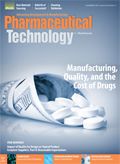News
Article
Pharmaceutical Technology
Managing Risk in Raw Material Sourcing
Author(s):
Vendor selection and materials testing are complex enough, but in today’s volatile environment, risk mapping and monitoring are also crucial.
Curioso/shutterstock.com

Choosing excipients and suppliers for pharmaceutical formulations requires a clear understanding of product requirements; material properties; product, process, and material variability; and vendor practices. The goal is a safe, robust formulation that will meet bioequivalence and stability requirements, but also enable validatable manufacturing, explained Chris Moreton, consultant with FinnBrit Consulting, during a September 2016 webcast (1).
But there are many factors at play that seem random and cannot be easily predicted-not only natural disasters, but what the statistician Nassim Nicholas Taleb has called “black swan” events (2), from sudden fires and plant accidents to geopolitical problems and the constant threat of economically-motivated product adulteration.
The burden is on finished-drug manufacturers to understand and manage all of these variables. A ripple effect is also being seen among proactive pharmaceutical ingredient suppliers, which are requiring more transparency from their suppliers. In a business environment in which final drug product manufacturers with even the most advanced programs can typically only see two levels deep into their supply chains (3), this represents progress. A number of technologies, and even effective do-it-yourself approaches, are available to help companies map and monitor supply chain risks (see Sidebar).
In light of the heparin, melamine, and other supply-chain disasters of recent years, there is more pressure than ever for pharmaceutical manufacturers to develop better supplier qualification practices, said Priscilla Zawislak, chair of the International Pharmaceutical Excipients Council (IPEC), on the webcast. Risk management is the key to avoiding batch failures, as well as adverse effects in patients, she explained. IPEC has developed standardized templates and materials to help simplify supplier evaluation and auditing, as well as the development of quality agreements (see Sidebar), and to ensure consistency. Having additional “just-in-case” suppliers on hand for key ingredients is also important to reduce risk, she said.
Data transparency now the norm
Pharmaceutical manufacturers are demanding not only cGMP compliance, documentation support, and close management of critical changes, but increased information transparency from their suppliers, says Devashish Ohri, executive vice-president with the API and excipient supplier, Avantor Performance Materials. In turn, some ingredients suppliers are requiring more provenance information from their suppliers. “Plant-of-origin information and transparency regarding the source of raw materials is essential for traceability,” he says.
Avantor has globalized and standardized quality systems at its facilities to help ensure consistency and continuity, establishing certified cGMP capacities in its facilities, including its site in Panoli, India, which, Ohri says, is ramping up production of J.T.Baker high-purity low endotoxin (HPLE) sugars, as well as multi-compendial cGMP excipients, in 2016.
“Our efforts are focused on compliance with the International Council for Harmonization’s (ICH) Q7 (for APIs) and IPEC (for bulk pharmaceutical excipients) guidelines to continuously improve our systems and ensure quality, safety, and functionality of pharmaceutical excipients,” says Ohri.
Guiding supplier selection, he says, are goals of consistent quality, uninterrupted supply, and availability of necessary documentation to support transparency efforts. Facility audits and product quality monitoring are an important part of supplier quality management, he says. Avantor has installed MasterControl quality management system (QMS) software across its cGMP manufacturing sites to manage documents, quality training, corrective actions and preventive actions, and other operations, says Ohri, who adds that ICH Q7 and IPEC guidelines helped shape the company’s change-management process. “It is important to ensure that any changes that might affect the products that customers buy or make, including changes to manufacturing processes, raw materials, product specifications, product transfers, and analytical testing, be managed and approved in a structured, cross-functional way,” he says.
To identify and assess risk, the company uses a documented risk-assessment process, facility audits, and a toolkit that includes such methods as failure modes and effect analysis, fishbone diagrams, and fault tree analysis, as well as hazards analysis and critical control point techniques, says Ohri. The company has established sites in the United States, Europe, and India, based on customer demand for local materials. For Avantor’s offshore suppliers, he adds, the use of (local) advisors helps ensure compliance and consistent performance.
Monitoring risks
Big Pharma companies and large generic-drug manufacturers have also been strengthening their supplier oversight and supply-chain risk monitoring practices. Several years ago, Pfizer made supply-chain security practices part of its quality manual, implementing an enterprise-wise scorecard for each supplier (4). J&J has set up supply chain risk monitoring centers of excellence and is using a filter of “reliability, risk, and readiness” to evaluate suppliers (3). Teva, meanwhile, has developed a systematic risk-based approach for reviewing suppliers, including their efforts in serialization (5).
References
1. “Best Practices for Effective Excipient Sourcing and Testing,” a Pharmaceutical Technology webcast, September 2016 (archived until September 20, 2017).
2. N. Taleb, The Black Swan: The Impact of Highly Improbable Events, Second Edition (Penguin, London, 2012).
3. A. Shanley, “Shipping: Proactive Risk Management,” PharmTech.com, April 2, 2016.
4. J. Skutnik-Wilkinson, “Management of the Supply Chain: Excipients and APIs,” a presentation made at the Pharmaceutical Quality Systems (ICH Q-10) Conference, October 4-6, 2011, Arlington, Va., FDA.gov.
5. A. Shanley, “Serialization: Getting Past the Quick Fix,” PharmTech.com, January 2, 2016.
Article Details
Pharmaceutical Technology
Vol. 40, No. 11
Pages: 58–60
Citation
When referring to this article, please cite it as A. Shanley, "Managing Risk in Raw Material Sourcing,” Pharmaceutical Technology 40 (11) 2016.

Newsletter
Get the essential updates shaping the future of pharma manufacturing and compliance—subscribe today to Pharmaceutical Technology and never miss a breakthrough.





